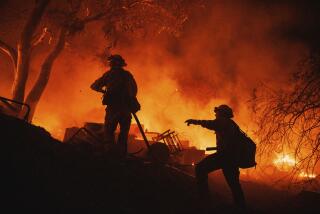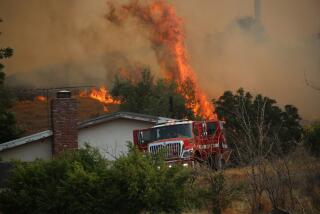Editorial: California wildfires are only going to get worse. We’re not ready
Countless research papers and government reports have said it, but the wildfires in Northern California this month brought it home: Climate change is fueling larger, more frequent and more devastating wildfires in the state, and communities have to start making themselves safer now.
Two of the three largest wildfires in California’s history have happened in the last four years. This year’s fires in wine country have been the deadliest in the state’s history, with 42 victims so far. Northern California is now experiencing the kind of wildfires that have rampaged through Southern California in recent years: fast, ferocious blazes that can wipe out suburban neighborhoods.
As higher temperatures and prolonged droughts bring more fires, models predict that the greatest property damage will be in the wildland-urban interfaces where developments abut foothills, forests or other open land. Roughly 6% of the state falls into this category, mainly in coastal Southern California, the Bay Area and the increasingly developed Sierra foothills.
California has to reckon with the fact that continued sprawl into previously undeveloped areas puts life and property at risk. This is not easy. The state has an extreme housing shortage, and it’s simpler in the short term to keep building outward than to redesign cities for greater density. But the threat of climate change has to force California to change the way it grows.
Starting this year, cities and counties are required by state law to develop policies to address the risks that climate change poses to their communities. That should force communities vulnerable to more frequent wildfires to evaluate how — or whether — new homes can be built safely on the urban edge.
The state requires that new buildings in zones deemed by the state to be at high risk of fire be made with fire-resistant materials, such as tile roofs. The state and local governments should also consider requiring older homes and buildings in high-risk zones to be retrofitted.
Unfortunately, urban areas often weren’t included by the state in its designated high-risk zones because, well, nobody expected a wildfire to sweep through a city. State officials are now revising the maps, and the fires around Santa Rosa must surely be a wake-up call that suburbia has to be made more fire resistant.
Californians also must recognize that making their communities more resilient to more intense wildfires will be an expensive, long-term proposition. That means removing dead trees and excess brush to reduce the fuel for fires. That means educating residents about how to protect themselves — like California practices for earthquakes, communities in high-risk zones should be developing wildfire drills. That means investing in fire-resilient communication and alert systems.
The risk of a major wildfire is growing for more California neighborhoods. State leaders, communities and residents must do a better job planning for them.
Follow the Opinion section on Twitter @latimesopinion and Facebook
More to Read
A cure for the common opinion
Get thought-provoking perspectives with our weekly newsletter.
You may occasionally receive promotional content from the Los Angeles Times.






